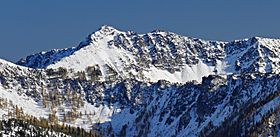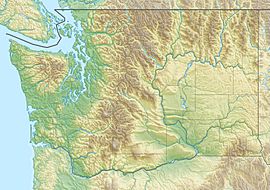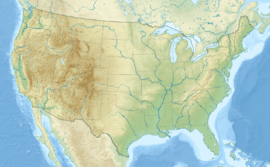Martin Peak (Methow Mountains) facts for kids
Quick facts for kids Martin Peak |
|
|---|---|

Martin Peak, northwest aspect
|
|
| Highest point | |
| Elevation | 8,375 ft (2,553 m) |
| Prominence | 855 ft (261 m) |
| Isolation | 2.06 mi (3.32 km) |
| Parent peak | Mount Bigelow (8,460 ft) |
| Geography | |
| Location | Okanogan County/Chelan County Washington, U.S. |
| Parent range | Methow Mountains North Cascades Cascade Range |
| Topo map | USGS Martin Peak |
| Climbing | |
| Easiest route | Scrambling |
Martin Peak is a tall mountain in Washington state. It stands 8,375-foot (2,553-metre) high. This makes it one of the highest peaks in the Methow Mountains. The Methow Mountains are part of the larger North Cascades mountain range.
Martin Peak is the seventh-highest peak in the Methow Mountains. It ranks 80th in all of Washington state. The mountain sits on a long line of peaks called Sawtooth Ridge. It is located where Martin Creek begins. The land around Martin Peak is part of the Okanogan-Wenatchee National Forest. Other mountains on Sawtooth Ridge include Oval Peak and Star Peak. The closest taller mountain is Mount Bigelow. It is about 2.06 miles (3.32 km) north of Martin Peak.
Mountain Weather: Martin Peak's Climate
The weather around Martin Peak is a bit drier than areas to its west. This is because it lies east of the main Cascade mountains. Summers can be warm and sometimes have thunderstorms. Most weather systems come from the Pacific Ocean. They travel northeast towards the Cascade Mountains.
When these weather systems reach the North Cascades, the tall mountains force the air upward. This causes the air to cool and drop its moisture. This moisture falls as rain or snow onto the Cascades. This process is called Orographic lift. Because of this, the North Cascades get a lot of rain and snow. This is especially true during winter.
Martin Peak is very tall, so it can have snow on its slopes in late spring. It can also have snow in early fall. Winters on the peak can be very cold. Water from the west side of the mountain flows into Lake Chelan. It gets there through Prince Creek. Water from the east side flows into Martin Creek. This creek then joins the Methow River.
How Mountains Form: Martin Peak's Geology
The North Cascades have some of the roughest land in the Cascade Range. You can see jagged peaks, sharp ridges, and deep valleys carved by glaciers. These amazing shapes and big changes in height were created by geological events. These events happened millions of years ago. They also led to the different climates and types of plants in the area.
The Cascade Mountains started forming millions of years ago. This was during a time called the late Eocene Epoch. The North American Plate is a huge piece of Earth's crust. It slowly moved over the Pacific Plate. This movement caused many volcanic eruptions.
Also, small pieces of Earth's crust, called terranes, crashed into the North American continent. These pieces helped build the North Cascades about 50 million years ago.
Later, during the Pleistocene period, glaciers played a big role. This was over two million years ago. Huge sheets of ice moved across the land many times. As they moved, they scraped away rock and left behind debris. The "U"-shaped valleys you see today were carved by these glaciers. The mountains also got taller through processes called uplift and faulting. These forces, along with the glaciers, created the tall peaks and deep valleys of the North Cascades.



